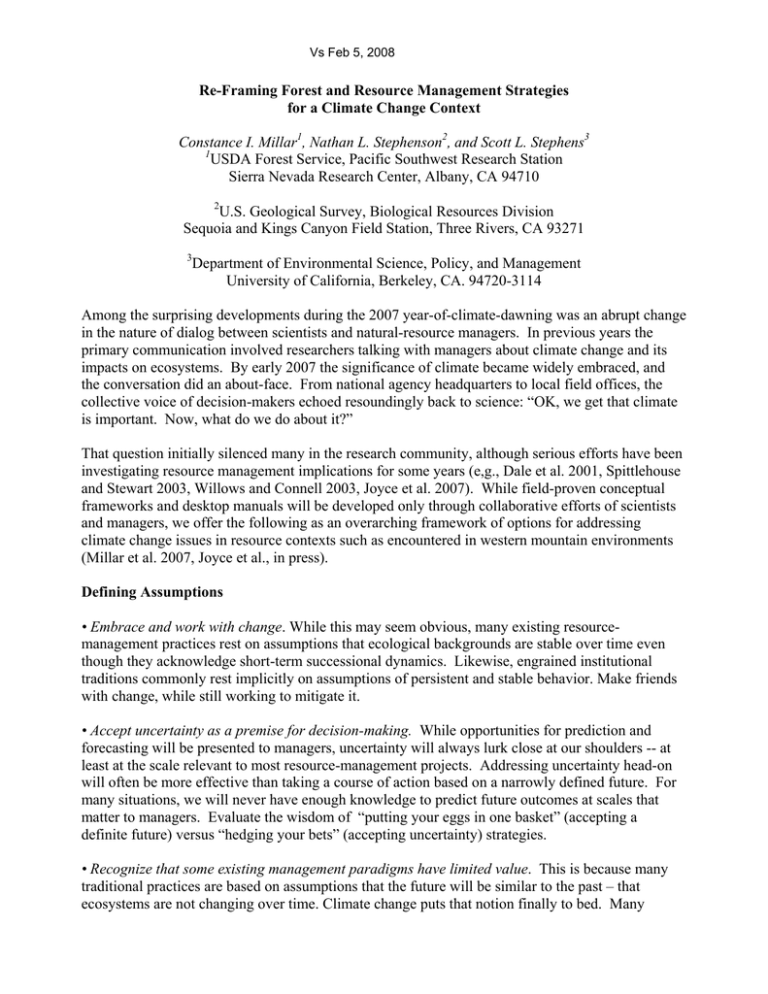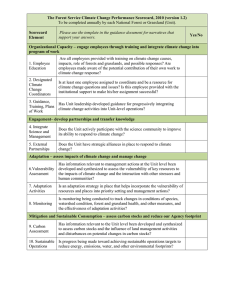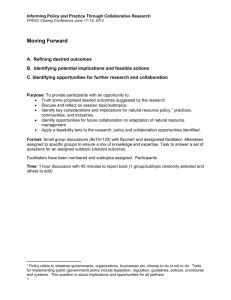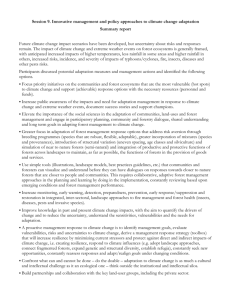Re-Framing Forest and Resource Management Strategies for a Climate Change Context
advertisement

Vs Feb 5, 2008 Re-Framing Forest and Resource Management Strategies for a Climate Change Context Constance I. Millar1, Nathan L. Stephenson2, and Scott L. Stephens3 1 USDA Forest Service, Pacific Southwest Research Station Sierra Nevada Research Center, Albany, CA 94710 2 U.S. Geological Survey, Biological Resources Division Sequoia and Kings Canyon Field Station, Three Rivers, CA 93271 3 Department of Environmental Science, Policy, and Management University of California, Berkeley, CA. 94720-3114 Among the surprising developments during the 2007 year-of-climate-dawning was an abrupt change in the nature of dialog between scientists and natural-resource managers. In previous years the primary communication involved researchers talking with managers about climate change and its impacts on ecosystems. By early 2007 the significance of climate became widely embraced, and the conversation did an about-face. From national agency headquarters to local field offices, the collective voice of decision-makers echoed resoundingly back to science: “OK, we get that climate is important. Now, what do we do about it?” That question initially silenced many in the research community, although serious efforts have been investigating resource management implications for some years (e,g., Dale et al. 2001, Spittlehouse and Stewart 2003, Willows and Connell 2003, Joyce et al. 2007). While field-proven conceptual frameworks and desktop manuals will be developed only through collaborative efforts of scientists and managers, we offer the following as an overarching framework of options for addressing climate change issues in resource contexts such as encountered in western mountain environments (Millar et al. 2007, Joyce et al., in press). Defining Assumptions • Embrace and work with change. While this may seem obvious, many existing resourcemanagement practices rest on assumptions that ecological backgrounds are stable over time even though they acknowledge short-term successional dynamics. Likewise, engrained institutional traditions commonly rest implicitly on assumptions of persistent and stable behavior. Make friends with change, while still working to mitigate it. • Accept uncertainty as a premise for decision-making. While opportunities for prediction and forecasting will be presented to managers, uncertainty will always lurk close at our shoulders -- at least at the scale relevant to most resource-management projects. Addressing uncertainty head-on will often be more effective than taking a course of action based on a narrowly defined future. For many situations, we will never have enough knowledge to predict future outcomes at scales that matter to managers. Evaluate the wisdom of “putting your eggs in one basket” (accepting a definite future) versus “hedging your bets” (accepting uncertainty) strategies. • Recognize that some existing management paradigms have limited value. This is because many traditional practices are based on assumptions that the future will be similar to the past – that ecosystems are not changing over time. Climate change puts that notion finally to bed. Many 2 ecosystem-management philosophies will still make sense, especially when practiced creatively. This is a good time to experiment with old techniques in new ways and pioneer altogether novel approaches. • Manage for desired future processes rather than desired future conditions. Composition and structure relate to static rather than dynamic goals; a focus on ecosystem services and ecological and physical functions as management targets fixes the aim on dynamic process. Overall Strategy: Adopt a Toolbox Approach No single solution and no individual management approach will be appropriate to all or even most situations. The diversity of resource contexts has always required that place-based and individualized prescriptions be developed; the climate-change context magnifies this reality. Understanding that a range of options exists, with some options appropriate to the short-term and others effective for the long-term, better positions decision-makers for the realities of changing times and dynamic landscapes. Below we suggest broad tools that currently occupy the toolbox – over time and with experience, the toolbox will grow and become filled with diverse and concrete examples, case studies, and lessons learned. Now and later, tools should be mixed and combined to best match the particular management context under consideration. Contents of the ToolBox: Adaptation, Mitigation and the “5-R Strategies” Adaptation and Mitigation. At the highest level in the toolbox are two broad climate-change strategies: adaptation and mitigation (IPCC 2007a). Adaptation implies all those approaches taken to adjust, prepare, and accommodate new conditions that are created by changing climates. Adaptations may be cultural and societal, for instances families deciding to purchase flood, fire, or windstorm insurance, or utility companies expanding energy capacities to accommodate unprecedented heat-wave surges. For natural-resource managers, adaptation strategies include those actions taken to assist natural resources (species, habitats, forest plantations, watersheds) in accommodating the changes and new conditions imposed by climate. Mitigation strategies include those actions taken to reduce and reverse the human influence on the climate system, primarily through reduction of greenhouse gas emissions and feedbacks. Adaptation and mitigation strategies are best considered joint paths – these primary tools optimally are combined and integrated. Thankfully, approaches to adaptation and mitigation will often be complementary: what is best management practice for one often is also for the other. However, especially in forest- and ecosystem-management situations, conflicts are very likely to arise. Thus, evaluating pros and cons of short- and long-term choices becomes extremely important. We outline five broad sub-strategies within the adaptation-mitigation toolbox. For didactic purposes, we call these the “5-R” strategies. They are summarized in order from most conservative to most pro-active; an informal “handle” is offered for each as a descriptive label. Adaptation Strategies: 1. Increase Resistance to Change. “Homeland Security” approach. Defending high-value resources against change is an appropriate and defensible, if short-term, approach for resource managers under certain circumstances. High-risk, high-value, and/or extremely urgent situations, such as critically vulnerable endangered species, extreme fire-risk situations, or volatile invasive species epidemics, are most appropriate subjects for resistance 3 management. In such cases, using great force to armor resource against change may be the best option. This action may be extremely expensive, take much time, resource, and staff effort, and be possible only for the short term. An example of resisting environmental change against great odds of success has been the program to captively propagate and reintroduce California condor. Other examples include creating in-situ refugia for endangered species, constructing thorough fire breaks, conducting early-detection rapid-removal programs on new invasions of undesired exotic species, or erecting tarps over snowfields in alpine ski-areas (Fig. 1). Resisting change may often be risky; in many situations conditions will eventually become so different that a resource threshold passes and resistance becomes futile. Then, an undesired consequence can be that the system ratchets forward catastrophically (burns, floods, falls into an extinction vortex). Thus, choosing to resist change might be considered a “paddling upstream” option. Adaptation Strategies: 2. Promote Resilience to Change. “Health Care” approach. Promoting resilience is the most commonly discussed adaptation strategy (Dale et al. 2001, Spittlehouse and Stewart 2003). When a species, habitat, watershed or other natural resource returns to its former condition or function after disturbance, it is said to have resiled. In that climate change brings new types and intensities of extreme events, management actions to promote resilience are those that improve the capacity to return to desired prior conditions after climate-induced disturbance. The widely held assumption, adopted from human health-care philosophy but relatively untested in natural ecosystems, is that “healthy” species, forests, ecosystems are more resilient to change. Thus, preventative treatments aimed at increasing health, are prescribed. Depending on the situation, these might include thinning dense forests, prescribing fires, stocking seed banks, or augmenting endangered species’ populations (Fig. 2). In mountain ski-resort communities, an action to promote resilience to climate-change-induced low-snow winters might be to add snowmaking equipment. As in resistance options, strategies to promote resilience are likely only successful in the relatively short-term, in that eventually changed climates will force new environmental conditions such that ecological re-setting rather than resilience will be “healthiest” path toward adaptation. Adaptation Strategies: 3. Enable Ecosystems and Resources to Respond to Change. “Beginner’s Mind” approach. Responding to and managing change is the most proactive approach we describe. This strategy assumes that a decision-maker acknowledges the inevitability of change and adopts the humility that we have limited capacity to understand what change will happen at the scales needed by managers. Many types of actions can assist species, ecosystems, or resources to move to new and adapted conditions and processes. Some choices are highly deterministic – that is, acting as if we can predict what changes will occur. Others are based on uncertainty about direction of change. The following are examples of possible tools: y Assist species and resources to follow changing environments. Using ecological and climatic knowledge, augmented with information from available downscaled regional climate models, directed decisions may be made about ecological restoration, reforestation, fire and flood reclamation, etc. For instance, species (seed, seedlings, capture/release individuals) could be moved from warmer (downhill, south aspect, or warm range margin) environments to cooler locations. Such an approach may entail moving propagules outside their current native ranges and into “neonative” locations (Millar 1998). This assisted migration remains little tested and highly debated in the scientific and conservation literature (McLachlan et al. 2006). Establishing forest or restoration projects on what had been considered “off-site” locations is another example of assisting species to 4 follow change, as is altering the composition of species in plantations from former associations to new mixes. y Anticipate and plan for associated risks. Already resource managers are experiencing the kinds of changes, especially in extreme events, that are catalyzed by climate change. These include, for instance, massive insect outbreaks and unprecedented forest diebacks, extreme fire events, fires and insect mortality in subalpine forests and other high-elevation environments, year-round fires, and extreme wind and flood events. Preparing for these, for instance by retaining entomological expertise, year-round fire staff including fire ecologists, and Wilderness resource monitoring, are proactive choices. y Experiment creatively and learn from experiments. By spreading risks and employing “bethedging” practices, much can be learned about how species adapt to new environments. This might entail, for instance: -- Using redundancy. In forest plantation, post-fire reforestation, or ecological restoration, using redundancy in project locations may be useful, e.g., planting on several traditionally non-optimal sites for species (up, down, different aspects, species range margins). -- Relaxing genetic-management guidelines. Rather than adherence to strict on-site or near-site germplasm standards and transfer rules for propagule collection and replacement, a choice may be made instead to augment genetic diversity by collecting from adjacent seedzones or populations for restoration projects (Fig. 3). -- Experimenting with refugia. From a paleo-ecological perspective, some types of environments appear to have buffered species through climate change better than others, and served as local refugia during adverse conditions. Establishing such areas as refugia for some kinds of species might prove successful in maintaining their persistence so that they can serve as propagule sources for adapted new populations. y Increase diversity. A widely held assumption, from financial investing to forest health, is that diverse conditions withstand threat and unstable times better than homogeneous conditions. Diversity also favors adaptive responses by increasing the pool of candidates available for selection in new environments. Increasing diversity in ecological habitat, forest plantations, riparian ecosystems, watershed conditions, or rural community capacities (extending from ski-resort to fourseason resort) may be a prudent strategy. Diverse landscape conditions break up opportunities for synchronous events, such as massive insect outbreaks (Mulholland et al. 2004) An opportune time to promote diversity is during post-disturbance management. y Promote connected landscapes. Over eons of natural climate change, species adapted primarily by migrating to new locations (range shifts). This is successful only when species have suitable habitat and adequate time to colonize new environments. Managers can assist this natural process by fostering connected landscapes (e.g., riparian zones), delineating large management-unit areas, lowering fragmentation, increasing management flexibility. Adaptation Strategies: 4. Realign Conditions to Current and Future Dynamics. “Auto-Mechanic” approach. For systems that have been pushed (manipulated, disturbed) far out of range of natural variability, actions that promote alignment with current conditions and processes may be the best approaches for restoration rather than returning to historic conditions. Using historic range of variability and returning habitats to pre-settlement or pre-disturbance conditions, which are widely used models for ecosystem restoration, will often be inappropriate because so much change has 5 occurred since pre-disturbance times. In western North America, for instance, pre-settlement period is the mid-1800s, which coincides with the coldest part of the Little Ice Age. Clearly these are inappropriate conditions to use as a target for the 21st century environments. Re-aligning or tuning to current and anticipated environments and processes is more likely to be successful (Fig. 4). Mitigation Strategies: 5. Reduce Greenhouse Gases and Reduce Non-Renewable Energy Use. “Good Samaritan” approach. The forestry sector in particular has an enormous opportunity to reduce human influences on the climate system. Reducing greenhouse gases can be achieved through forest and wildand management actions designed so that sequestration is enhanced, carbon stored in natural resources (wood, fiber, soil) is retained longer, emissions are lowered (by reducing severe fire), and non-fossil fuel alternative energy favored (e.g., biomass utilization) (Fig. 5). By contrast, poor management, lack of management, or inadequate capacity to manage can inadvertently accelerate negative effects, for instance through increase of large, catastrophic forest fires. All resource sectors have abundant opportunities for reducing energy consumption and reducing the human energy footprint. Increasingly these options are available in all aspects of our work and personal lives. Carbon markets and law and policy (e.g., California AB-32, the California GlobalWarming Solutions Act) promote actions designed to reduce human influence on climate. Setting Priorities Climate-change pushes the resource-manager’s already full plate to overflow. More than ever, demands will exceed capacity and conflicts among choices will have higher stakes. Evaluation of options and setting priorities will be increasingly important. At an overall level, decision-makers have three options for engaging climate-management, each defensible under different scenarios. They can do nothing (no advance planning), react after disturbance or extreme events (when trajectories are often adaptively reset under natural conditions) or act proactively in advance (Joyce et al. in press). Priority-setting is a science in itself; several approaches to priority setting have been discussed in the context of climate change. These include tiered approaches such as no-regrets, low regrets, win-win (Willows and Connell 2003), and employing low- to high-technology approaches judiciously (Ralph 2007). Formal triage approaches, developed and used widely in military and emergency medicine, can be successfully adopted in resource situations whenever time is short and capacity to meet urgent demands inadequate. Systematically evaluating vulnerabilities provides an essential first step in all approaches (IPCC 2007b). In Sum We describe a preliminary framework appropriate to western mountainous environments for developing forest and natural-resource management strategies in the face of climate change. Adaptation and mitigation approaches may be divided into short- and long-term options following the “5-R strategies”: Increase resistance, promote resilience, enable response, encourage realignment, and implement practices to reduce the human influence on climate. Priority-setting, especially embracing methods that empower decision-making under urgent contexts where demand is greater than capacity to respond becomes very important. While general principles will emerge, the best preparation is for managers and planners to stay closely turned to local environments and resources, remain informed about relevant emerging climate science in their regions, and to use that 6 knowledge to shape effective local solutions. A goal of this article is to engage dialogue on this issue. References Cited Dale, V., Joyce, L., McNulty, S., Neilson, R., Ayres, M., Flannigan, M., Hanson, P., Irland, L., Lugo, R., Peterson, C., Simberloff, D., Swanson, F., Stocks, B., Wotton, M. 2001. Climate change and forest disturbances. BioScience 51: 723-734. Joyce, L., Haynes, R., White, R., Barbour, J. (eds.), 2007. Bringing climate change into natural resource management. USDA Forest Service, General Technical Report, GTR-PNW-706; 150 pgs. Joyce, L.A., Blate, G.M., Littell, J.S., McNulty, S.G., Millar, C.I., Moser, S.C., Neilson, R.P., O’Halloran, K., Peterson, D.L. In press. Adaptation options for climate-sensitive ecosystems and resources. National forests. Chapter 3. Climate Change Science Program. Synthesis and Adaptation Products 4.4. (Online at: http://www.climatescience.gov/Library/sap/sap4-4/publicreview-draft/default.htm) IPCC. 2007a. Climate change 2007: the physical science basis. Summary for Policy Makers. Contribution of Working Group 1 to the Fourth Assessment Report of the Intergovernmental Panel on Climate Change. IPCC. 2007b. Impacts, adaptation, and vulnerability. Contribution of Working Group II to the Fourth Assessment Report of the IPCC. McLachlan, J.S. Heilmann, J., Schwartz, M. 2007. A framework for debate of assisted migration in an era of climate change. Conservation Biology 21: 297-302. Millar, C.I., 1998. Reconsidering the conservation of Monterey pine. Fremontia 26(3) 12-16 Millar, C.I., Stephenson, N.L., and Stephens, S.L, 2007. Climate change and forests of the future: Managing in the face of uncertainty. Ecological Applications 17(8): 2145-2151. Mulholland, P., Betancourt, J., Breshears, D.D. 2004. Ecological impacts of climate change: Report from a NEON science workshop. American Institute of Biological Sciences, Tucson, AZ. Ralph, F.M. 2007. A 21st century observing system for California weather and climate: Current plans and future possibilities. Fourth Annual California Climate Change Conference. Sacramento, CA, http://www.climatechange.ca.gov/events/2007_conference/ Ritchie, M.W., Skinner, C.N., and Hamilton, T.A. 2007. Probability of tree survival after wildfire in an interior pine forest of northern California: Effects of thinning and prescribed fire. Forest Ecology and Management 247: 200–208. 7 Spittlehouse, D.L. and Stewart, R.B. 2003. Adaptation to climate change in forest management. BC Journal of Ecosystems and Management 4 (1): 1-11. Willows, R. and R. Connell (editors). 2003. Climate adaptation: Risk, uncertainty, and decisionmaking. UK Climate Impacts Programme, Oxford, England. 8 Figure Captions Fig. 1. Managing for resistance to change. Invasion by lodgepole pine (Pinus contorta) is a common response to warming 20th-21st century conditions in Sierra Nevadan meadows. At Tuolumne Meadows, Yosemite National Park, CA, climate change and other historic land uses have interacted to promote recurrent colonization episodes of pine (A). National Park Service managers have chosen to resist and counter these effects by periodically removing pine seedlings and small trees (B). Photo: C. Millar. Fig. 2. Promoting resilience to change. Before- (upper) and after- (lower) thinning treatments to improve resilience to wildfire in pine forests at the Blacks Mountain Experimental Forest, northern Sierra Nevada, CA. The treatment included mechanical thinning plus prescribed fire; resilience was proven highly effective in the treated areas in the aftermath of the 2002 Cone Fire (Ritchie et al. 2007). Photo: John Ahnstead, USFS. Fig. 3. Enabling response to change. Seed transfer rules, based on zones such as those of the California federal, state, and private forest-genetic programs, have been developed to restrict movement of germplasm from source areas to restoration locations under the assumption that local genotypes are better adapted than non-local. Relaxing the guidelines and increasing diversity by mixing small percentages of seed from zones adjacent to the restoration sites may improve adaptation in the face of changing climates. Photo: California Dept. of Forestry and Fire Protection. Fig. 4. Realigning ecosystems far out of the range of natural variability. Rather than using the common rule to target historic pre-disturbance conditions and lake level elevation as a restoration effort for Mono Lake’s aquatic ecosystem, the 1990 court settlement and subsequent policies used water balance and climate models to develop goals that would re-align the lake level to current dynamics and anticipated future climates. Photo: C. Millar. Fig. 5. Reducing greenhouse gas emissions. Biomass production from wood fiber removed during forest fuel reduction treatments provides alternative energy, thereby reducing fossil-fuel dependent energy consumption and ultimately lowering greenhouse gas emissions. Photo: Mark Nechodom, USFS. 9 Figure 1 10 Figure 2 11 Figure 3 12 Figure 4 Figure 5




